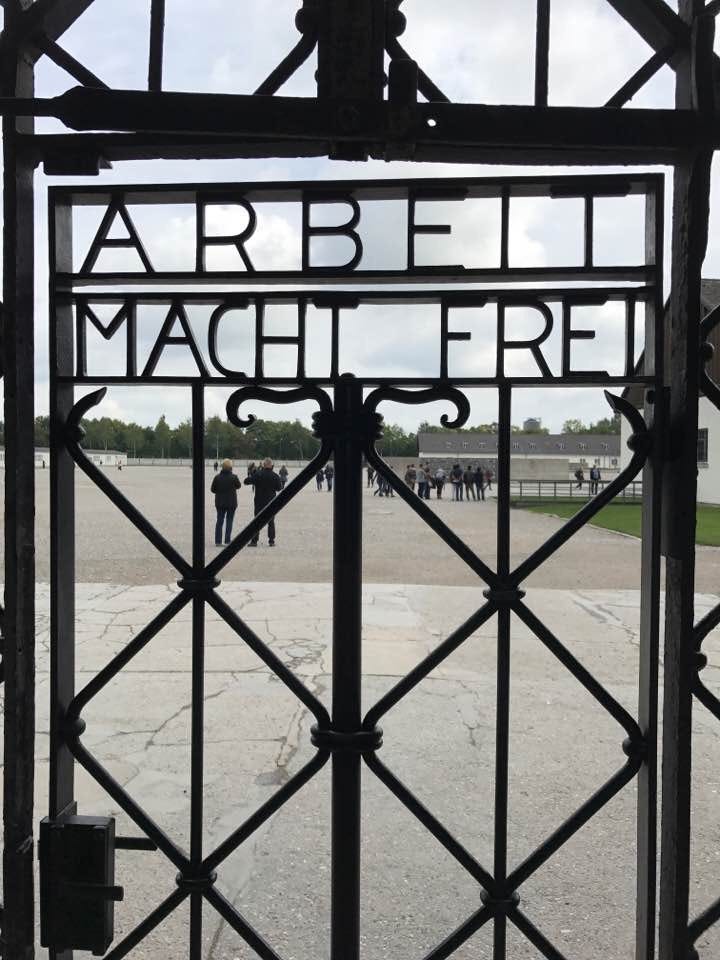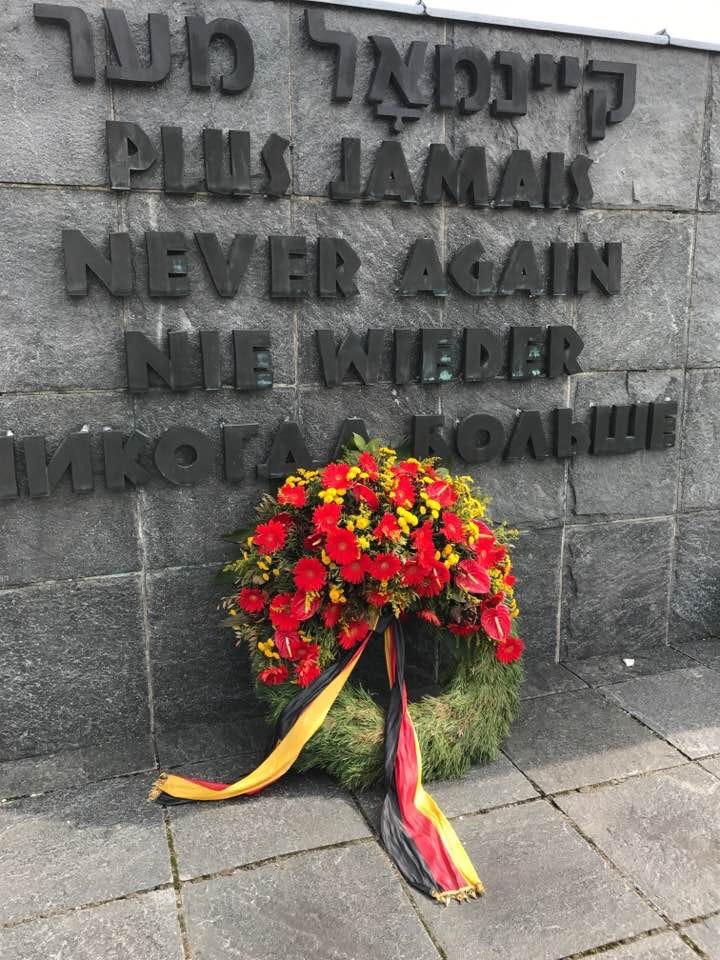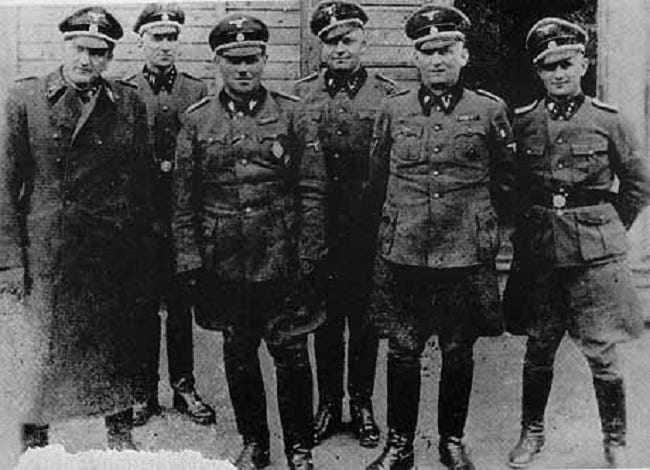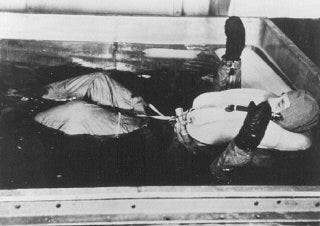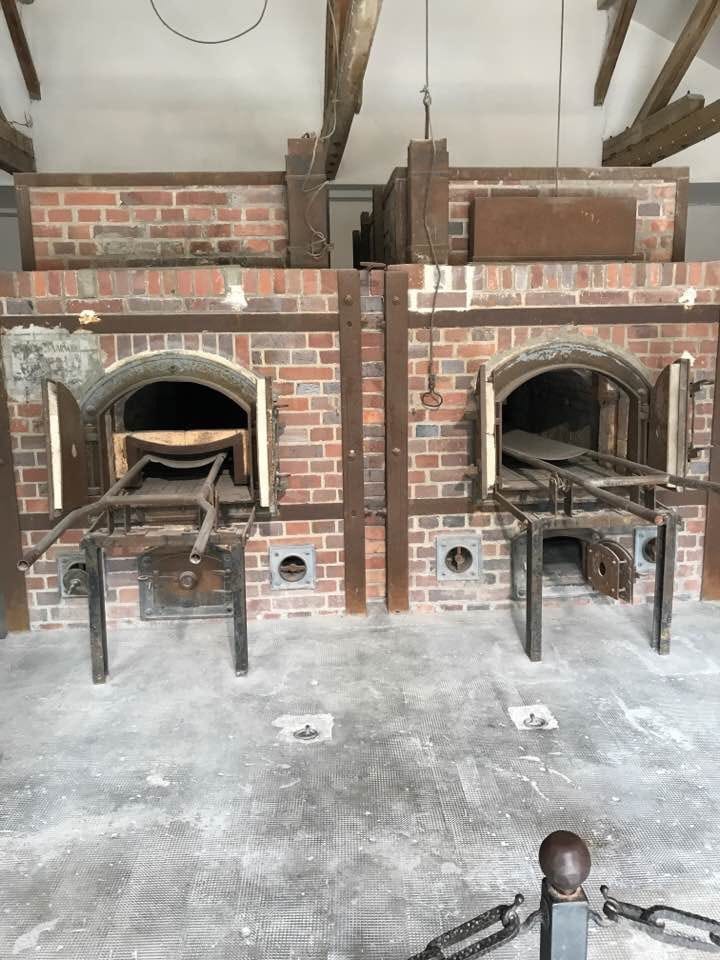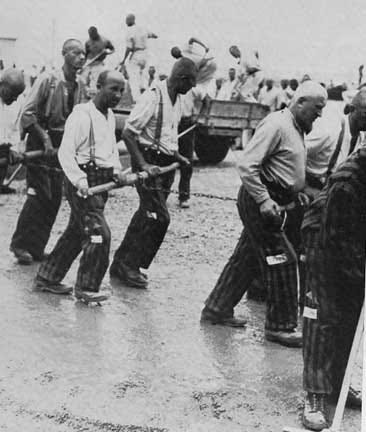The Liberation of Dachau, the Nazi Model Camp of Extrajudicial Terror and Heinous Medical Experiments
Today is the 79th anniversary of the liberation of the Dachau Concentration Camp outside of Munich by soldiers of the U.S. 42nd and 45th Infantry Divisions. The soldiers entered a hellscape of horror. Emaciated survivors greeted their liberators amid a scene of unburied bodies, bodies of people stacked in freight cars evacuated from other camps who died before they got to Dachau, and bodies stacked near the camp’s gas chamber and crematorium. The vision horrified the soldiers and some reacted by summarily executing about 50 captured SS guards.
I first visited Dachau on a bleak November day in 1996. My train from Würzburg pulled into the station where so many victims arrived to meet death, or fates which can arguably by called worse than death. It was foggy with temperatures a bit above freezing. I walked the city streets to the camp, which are marked so visitors can see the path the victims walked to the front wrought iron gate emblazoned with the cynical greeting Arbeit Macht Frei, or Work Makes you Free. Since that day I have made seven other visits to conduct research, to introduce others to it, and to make a sacred pilgrimage to remember the victims of the Nazi horror, and commit to ensuring that it never happens again.
Today Dachau is a Gedenkstätte, or Memorial site. The German government has preserved the grounds, rebuilt examples of the barracks, established a museum, and built a memorial where the victims are commemorated with the words “Never Again” written in Hebrew, French, English, German, and Russian. The camp is about a half hour drive from Munich and can be reached by taking the S2 from the Munich Hauptbahnhof in the direction Dachau/Petershausen.
In order that my readers understand the horror I provide a brief history with photographs from when the camp was operational, as well as my own photos taken during my visits.
The Main Thoroughfare 1938
German government and three days before the passage of the Enabling Act the Police President Of Munich, SS Reichsführer Heinrich Himmler ordered the establishment of the Dachau Concentration Camp. He appointed SS Standartenführer Hilmar Wäckerle as Commandant and the first 200 political prisoners from Munich’s Stadelheim prison arrived at Dachau on March 22nd.
Wäckerle’s brief tenure as Commandant was marked by extraordinary brutality on the part of his staff, so much so that charges were brought against him by the Munich courts which resulted in his relief by SS Gruppenführer Theodore Eicke in July 1933. Eicke would establish the regulations which governed all the later Concentration Camps, and make Dachau the model camp for all others.
Among the later SS killers of the Holocaust who served at Dachau were Adolf Eichmann, and the Commandant of Auschwitz, Rüdolf Höss. It became a training ground for other Concentration Camp commanders and staff. Others would become leaders in the Waffen SS and the Einsatzgruppen death squads.
The announcement of Dachau’s Opening was reported by the German press in this release:
On Wednesday the first concentration camp is to be opened in Dachau with an accommodation for 5000 people. ‘All Communists and—where necessary—Reichsbanner and Social Democratic functionaries who endanger state security are to be concentrated here, as in the long run it is not possible to keep individual functionaries in the state prisons without overburdening these prisons, and on the other hand these people cannot be released because attempts have shown that they persist in their efforts to agitate and organize as soon as they are released.
The order was unprecedented, for Dachau operated extrajudicially, not as an organ of the Star, but as an organ of the Nazi Party. Many of the prisoners had been tried and acquitted in the German Court system, but the Gestapo was waiting for them when they left the court or the prisons where they were being held and transported to Dachau or other Concentration Camps without having been tried, sentenced, or given a sentence that indicated how long they would be incarcerated.
Dachau began as a political prisoner camp for the Nazis to imprison Socialists, Communists, Jehovah’s Witnesses, some Jews, and other dissidents. It wasn’t a “death camp” designed to exterminate people even though tens of thousands of people died or were executed there.
It was designed to terrorize, dehumanize, and destroy the souls of its inmates. It was a place of inhuman medical experiments, which used the inmates in human experiments designed to improve the chances of German airman and other military personnel at the expense of the lives of the prisoners. Most were subjected to high altitude tests in a chamber that mimicked the effects of oxygen deprivation at high altitudes and what could be done to treat those suffering from it, as well as freezing and body cooling experiments where again prisoners were used to attempt to find best method of rewarding their bodies from freezing water temperatures. In all cases, any prisoner who survived the experiments was euthanized. The head of many of these experiments was SS and Luftwaffe Dr. Sigmund Rascher. At Dachau Rascher conducted hundreds of experiments on prisoners. Those selected for the hypothermia tests were forced to remain outdoors naked in freezing weather for up to 14 hours, or kept in a tank of icewater for three hours, their pulse and internal temperature measured through a series of electrodes. Warming of the victims was then attempted by different methods, most usually and successfully by immersion in hot water; at least one witness, an assistant to some of these procedures, later testified that some victims were thrown into boiling water for rewarming.
A Victim of Rascher’s Freezing Experiments
Rascher, with Himmler’s permission also conducted experiments with poison injections of cyanide, or gas in Dachau’s gas chamber.
The Crematorium
Unlike those in the Poland explicitly used to murder mass numbers of Jews, Dachau’s chamber was used for experiments on limited numbers of prisoners. One of the prisoner doctors, Dr. Franciszek Blaha, a Communist prisoner from Czechoslovakia, testified at Nuremberg:
“Numerous executions with gas, by shooting or injections were carried out in the camp itself. The gas chamber was completed in 1944 and I was called by Dr. Rascher to examine the first victims. Out of the eight or nine persons in the room, three were still alive, the rest appeared to be dead. Their eyes were red and their faces swollen. Later on, many inmates were killed in this way. Subsequently they were moved to the crematorium where I was to check their teeth for gold. The teeth containing gold were extracted. Many inmates who were ill, were killed by injections while in the hospital. Some of the inmates who had been killed there, came into the autopsy room without a name of number on the label that was usually tied to their big toe. Instead, “no autopsy” was written on the label. I carried out post mortems on some of them and discovered they had been completely healthy but had died from injections. Sometimes inmates were killed just because they has dysenteria or because they had vomitted and were causing too much trouble for the nurses. Mental patients were liquidated by taking them to the gas chamber where they were either injected or shot. Shooting was a customary method of execution. Inmates could be shot right outside the crematorium and taken inside. I have seen people being pushed into the ovens, still breathing and making noises, although when they were still too much alive they were usually beaten on their heads.“
Dachau was a place of terror, and the administrative center of a network of over 30 large and 100 small sub-Camps which were used as sources of slave labor for the German armaments industry. As the war broke out and continued, the SS rented prisoners to German industrial giants, many with plants in the Munich area.
Prisoners working on Construction Projects 1938
But one has to remember that the SS was not simply an instrument of terror, but an institution devoted to profit. Prisoners were valued in what their lives equated in profits. A prisoner was valued in what he or her could produce versus the expenses of keeping them alive for a period of 6 to 12 months. Under Himmler and his assistant for production and profits, Obergrüppenfuhrer Oswald Pöhl the Concentration Camps, as well as the death camps became centers of profit for the SS in collaboration with German industrial concerns and industries owned by the SS itself.
There were many other crimes against humanity committed at Dachau, and it provided the commanders to other camps including Auschwitz, where Rudolf Höss ran a hybrid camp, part regular Concentration Camp and labor camp, with connections to SS run or private industrial corporations, as well as a camp where Medical experiments were conducted by Josef Mengele, as well as a death camp at which over a million people, primarily Jews, were exterminated in gas chambers that could accommodate up to 2,000 people in one operation. When asked about the operations at Auschwitz Höss, who had been called by the Defense at Nuremberg to give Earnest Kaltenbrunner an alibi for not visiting Auschwitz, was cross examined by the prosecution. His answers were damning, not only to him but to the entire Concentration Camp system stated:
“when I was appointed Commandant of Auschwitz. I commanded Auschwitz until 1 December 1943, and estimate that at least 2,500,000 victims were executed and exterminated there by gassing and burning, and at least another half million succumbed to starvation and disease making a total dead of about 3,000,000. This figure represents about 70 or 80 percent of all persons sent to Auschwitz as prisoners, the remainder having been selected and used for slave labor in the concentration camp industries; included among the executed and burned were approximately 20,000 Russian prisoners of war (previously screened out of prisoner-of-war cages by the Gestapo) who were delivered at Auschwitz in Wehrmacht transports operated by regular Wehrmacht officers and men. The remainder of the total number of victims included about 100,000 German Jews, and great Numbers of citizens, mostly Jewish, from Holland, France, Belgium, Poland, Hungary, Czechoslovakia, Greece, or other countries. We executed about 400,000 Hungarian Jews alone at Auschwitz in the summer of 1944…
The ‘final solution’ of the Jewish question meant the complete extermination of all Jews in Europe. I was ordered to establish extermination facilities at Auschwitz in June 1941. At that time, there were already in the General Government three other extermination camps: Belzek, Treblinka, and Wolzek. These camps were under the Einsatzkommando of the Security Police and SD. I visited Treblinka to find out how they carried out their exterminations. The camp commandant at Treblinka told me that he had liquidated 80,000 in the course of onehalf year. He was principally concerned with liquidating all the Jews from the Warsaw Ghetto. He used monoxide gas, and I did not think that his methods were very efficient. So when I set up the extermination building at Auschwitz, I used Cyklon B. which was a crystallized prussic acid which we dropped into the death chamber from a small opening. It took from 3 to 15 minutes to kill the people in the death chamber, depending upon climatic conditions. We knew when the people were dead because their screaming stopped. We usually waited about onehalf hour before we opened the doors and removed the bodies. After the bodies were removed our special Kommandos took off the rings and extracted the gold from the teeth of the corpses…
Another improvement we made over Treblinka was that we built our gas chamber to accomodate 2,000 people at one time whereas at Treblinka their 10 gas chambers only accommodated 200 people each. The way we selected our victims was as follows: We had two SS doctors on duty at Auschwitz to examine the incoming transports of prisoners. The prisoners would be marched by one of the doctors who would make spot decisions as they walked by. Those who were fit for work were sent into the camp. Others were sent immediately to the extermination plants. Children of tender years were invariably exterminated since by reason of their youth they were unable to work. Still another improvement we made over Treblinka was that at Treblinka the victims almost always knew that they were to be exterminated and at Auschwitz we endeavored to fool the victims into thinking that they were to go through a delousing process. Of course, frequently they realized our true intentions and we sometimes had riots and difficulties due to that fact. Very frequently women would hide their children under the clothes, but of course when we found them we would send the children in to be exterminated. We were required to carry out these exterminations in secrecy but of course the foul and nauseating stench from the continuous burning of bodies permeated…”
Höss had learned well at Dachau. He learned to follow his orders without question, and was willing to speak of his crimes in open court.
I have been to Dachau, Bergen-Belsen, Flossenburg, and Buchenwald. I have also been to the T4 Euthanasia Center at Hadamar. To walk through these places where human beings subjected other people to the most inhuman of conditions, punishments, and torture brings the reality of the Holocaust into stark reality. The great evil committed by the Nazis in these places have made them hallowed ground.
U.S. Army Soldiers View Bodies in a Cattle Car
We live in a day where American politicians are openly antisemitic, where Neo-Nazis, White, and Christian Nationalists spew forth race hatred directed at Jews, Blacks, Asians, other immigrants, and LTBTQ people, all while threatening political opponents with death and extrajudicial punishment.
Never forget the words of Yehuda Bauer:
“The horror of the Holocaust is not that it deviated from human norms; the horror is that it didn’t. What happened may happen again, to others not necessarily Jews, perpetrated by others, not necessarily Germans. We are all possible victims, possible perpetrators, possible bystanders.”
Dedicated to the Proposition that All are Created Equal is sustained by paid subscriptions, making it possible to keep nearly all the writing available for everyone. If you’re not already a paid subscriber, I hope you’ll consider becoming one.
Founding Members will receive an inscribed copy of my book Mine Eyes Have Seen the Glory: Religion and the Politics of Race in the Civil War Era and Beyond.




